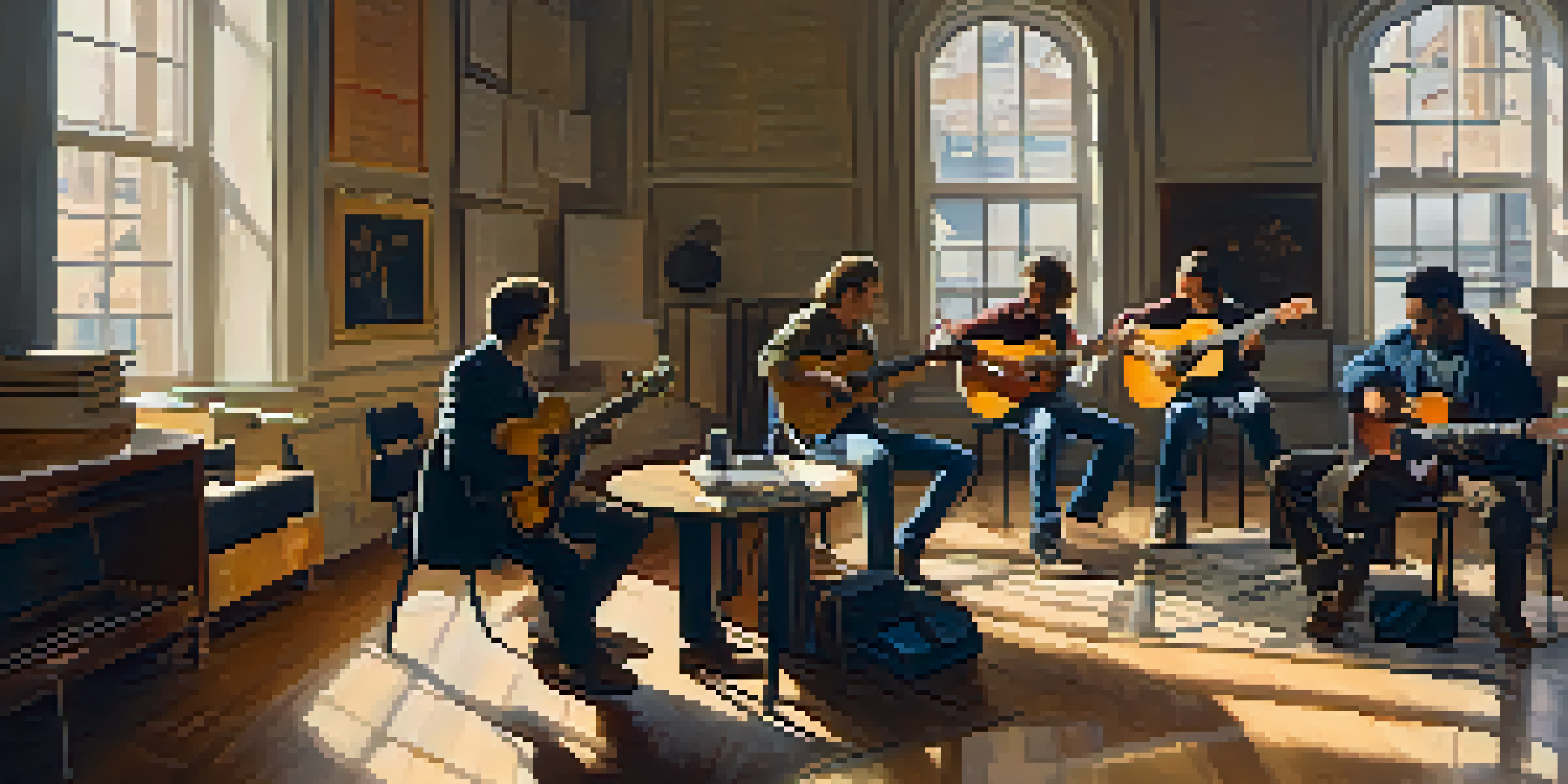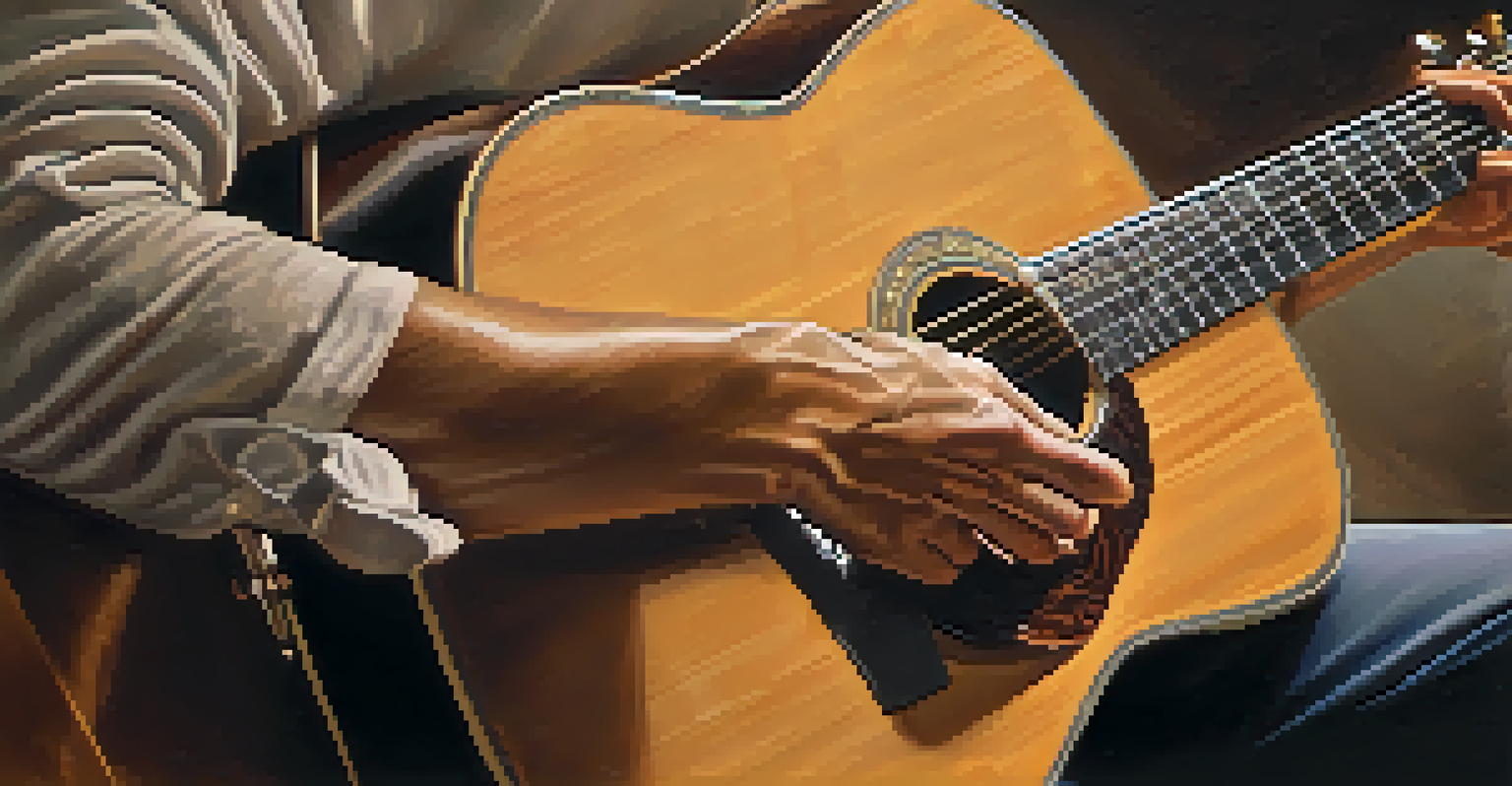Essential Techniques for Successful Guitar Ensemble Playing

Understanding the Role of Each Guitar in the Ensemble
In any guitar ensemble, it's crucial to understand the distinct roles each guitar plays. Whether you're a lead guitarist, rhythm player, or a bassist, each part contributes to the overall sound. For instance, the lead guitar often carries the melody, while the rhythm guitar provides the harmonic foundation.
The beautiful thing about learning is that no one can take it away from you.
Recognizing these roles helps in creating a cohesive sound. When each player is aware of their responsibilities, it allows for smoother transitions and more dynamic performances. Think of it like a well-orchestrated team, where everyone knows their plays.
Moreover, understanding these roles can lead to better communication within the group. Musicians who are aware of their functions can provide constructive feedback to each other, enhancing the ensemble's overall performance quality.
Effective Communication Among Ensemble Members
Communication is the backbone of any successful ensemble. This doesn’t just mean talking; it involves listening and responding to each other’s cues during practice and performance. Developing a shared musical vocabulary can streamline this process.

For example, using visual cues, like nods or hand signals, can help maintain the tempo or cue changes without disrupting the flow. This is especially useful in larger groups where sound can easily get muddled. It’s like conducting an orchestra, where clear signals lead to beautiful harmonies.
Roles in Guitar Ensembles
Understanding the distinct roles of each guitarist fosters a cohesive sound and enhances communication within the group.
Additionally, regular discussions about dynamics, tempo, and phrasing can enhance the ensemble's performance. Setting aside time to reflect on what works and what doesn’t fosters an open environment where everyone can contribute.
Mastering Timing and Rhythm in Ensemble Play
Timing and rhythm are essential for any musical group, and guitar ensembles are no exception. A tight rhythm section can make or break a performance. Using a metronome during practice can help each member lock into a steady beat, ensuring that everyone is on the same page.
Music brings people together. It's a language that everyone can understand.
Practicing with a backing track can also improve timing. It provides a real-world context, making it easier to feel how your part fits within the larger composition. Just like a clock, each guitarist needs to tick in harmony to create a beautiful piece.
In addition, learning to play syncopated rhythms can add complexity and interest to your ensemble sound. This technique requires practice but can elevate your playing and make your performances stand out.
Choosing the Right Repertoire for the Group
Selecting the right pieces for your ensemble is crucial for showcasing each guitarist’s strengths. Consider the skill levels and styles of the group members when choosing songs. A well-chosen piece will challenge the group while still allowing for enjoyable play.
For instance, if your ensemble has a mix of beginners and advanced players, opt for arrangements that allow for both simple and complex parts. This way, every member can contribute meaningfully, making it a more inclusive experience.
Understanding Guitar Roles
Each guitarist's role, whether lead, rhythm, or bass, is essential for creating a cohesive ensemble sound.
Additionally, incorporating a variety of genres can keep rehearsals fresh and exciting. From classical to rock, diverse repertoire can motivate members and broaden their musical horizons.
Building a Strong Ensemble Identity and Sound
Every successful guitar ensemble develops a unique sound and identity over time. This cohesive voice comes from blending individual styles and techniques. Encourage members to bring their personal flair, which can lead to innovative arrangements.
Experimenting with different harmonies and guitar effects can also shape your ensemble's identity. For example, adding a chorus effect on one guitar while keeping others clean can create a lush soundscape. It’s like painting a picture; each color adds depth and character.
Creating an ensemble identity not only enhances performances but also fosters a sense of belonging among members. This shared identity can strengthen bonds and motivate everyone to strive for excellence.
Practicing Together: Techniques for Effective Rehearsals
Regular rehearsals are vital for any ensemble's success. However, how you practice can make a significant difference. Focus on structured rehearsals that balance individual practice with group work to ensure everyone is on the same wavelength.
For instance, starting with warm-up exercises can get everyone in sync before diving into the repertoire. Breaking down complex pieces into smaller sections can also make learning more manageable and less overwhelming.
Effective Communication is Key
Clear communication through cues and discussions enhances performance and fosters collaboration within the group.
Incorporating feedback sessions at the end of rehearsals encourages continuous improvement. Openly discussing what worked and what needs attention can enhance future performances, making each session more productive.
Performing with Confidence and Stage Presence
Stage presence is everything when performing as a guitar ensemble. It’s not just about playing well; it’s also about engaging the audience. Encourage all members to project confidence, whether through posture or facial expressions.
Rehearsing in front of friends or family can help members get comfortable with performing. This practice can simulate the pressure of a live audience, allowing the ensemble to polish their act. Think of it as a dress rehearsal before the big show.

Additionally, incorporating movements and interactions between members can enhance the visual appeal of your performance. This not only captivates the audience but also showcases the chemistry and connection within the ensemble.
Embracing Feedback and Continuous Improvement
Feedback is a crucial component of growth for any guitar ensemble. Creating an environment where members feel comfortable giving and receiving constructive criticism can lead to significant improvements. Remember, feedback should be specific and actionable.
After performances, take time to reflect as a group. Discuss what went well and what could be refined for next time. This reflection is like a mirror, helping you see your strengths and areas for growth.
Embrace Feedback for Growth
Constructive feedback after performances encourages continuous improvement and strengthens the ensemble's overall quality.
Moreover, embracing feedback fosters a culture of continuous improvement. As each member learns and evolves, the ensemble grows stronger, paving the way for even more impressive performances in the future.